(Press-News.org) Where Atlantic salmon feed in the ocean has been a long-standing mystery, but new research led by the University of Southampton shows that marine location can be recovered from the chemistry of fish scales. Surprisingly, salmon from different British rivers migrate to feed in separate places, and may respond differently to environmental change.
Numbers of Atlantic salmon have declined across their range since the early 1970s, and most researchers believe that conditions experienced at sea are largely to blame. Unfortunately, identifying where salmon go to feed in the huge expanse of the North Atlantic is difficult as attaching artificial tags to fish is expensive. A paper published this week in Scientific Reports shows that fish carry natural records of feeding location hidden in the chemistry of their scales.
The chemistry of animal tissues reflects the composition of food and water in the area where they live and feed, and can act as a natural tag. Using this idea, the Southampton team, working with scientists from the Centre for Environment, Fisheries and Aquaculture Science (Cefas), the Game and Wildlife Conservation Trust (GWCT) and the National Oceanography Centre (NOC), looked at the isotopes of carbon contained in historical records of scales of Atlantic salmon. The scales grew while the salmon were feeding at sea, so the carbon isotope values of the scales reflect the values of their diet in the feeding grounds. The team compared the scale values through time with satellite records of sea surface temperature across the North Atlantic. The locations of sea where the time series match best are most likely to be the areas where the fish have been feeding.
"As every single salmon contains the natural chemical tag, we can now see where fish from individual rivers go to feed in the Atlantic," lead author Dr Kirsteen MacKenzie said. "Interestingly, we found that salmon born in two areas of the British Isles swim to feeding grounds that are far apart, and experience very different conditions while at sea". Co-author Dr Clive Trueman continued: "This information allows for better management of individual fish populations by monitoring both environmental conditions and fishing efforts in the areas where they feed". "Our technique can also be used to aid conservation of animals such as turtles, seabirds and tuna, and identify the best areas for marine protection measures," added Dr MacKenzie.
INFORMATION:
This research was funded by Defra, (Department for Environment, Food and Rural Affairs, UK).
Discovering lost salmon at sea
2011-06-24
ELSE PRESS RELEASES FROM THIS DATE:
Parenting Time Plans in Oregon
2011-06-24
Oregon law requires that a parenting time plan be included in all judgments where minor children are involved.
In Oregon, "parenting time" (called "visitation" in some states) is the scheduled time that each parent has with the children. The parenting time plan is a document that states when the children will be with each parent and how decisions will be made for the parties' children.
The amount of parenting time that each parent has with the children is not necessarily related to whether or not a parent has legal custody in Oregon. In Oregon, ...
Building a better math teacher
2011-06-24
For years, it has been assumed that teachers—specifically math teachers—need to master the content they intend to teach. And the best way to do this is to take courses beyond that content.
Yet in a paper published today in the Education Forum of the journal Science, Dr. Brent Davis of the University of Calgary says research does not support this common belief. There is little evidence that advanced courses in mathematics contribute to more effective teaching.
"You know that feeling, when you try to explain to a child how to add multi-digit numbers, and you realize that ...
Ghrelin likely involved in why we choose 'comfort foods' when stressed
2011-06-24
DALLAS – June 23, 2011 – We are one step closer to deciphering why some stressed people indulge in chocolate, mashed potatoes, ice cream and other high-calorie, high-fat comfort foods.
UT Southwestern Medical Center-led findings, in a mouse study, suggest that ghrelin – the so-called "hunger hormone" – is involved in triggering this reaction to high stress situations.
"This helps explain certain complex eating behaviors and may be one of the mechanisms by which obesity develops in people exposed to psychosocial stress," said Dr. Jeffrey Zigman, assistant professor ...
Ovenbirds eavesdrop on chipmunks to protect nests
2011-06-24
Ground-nesting birds face an uphill struggle to successfully rear their young, many eggs and fledglings falling prey to predators. Now, scientists from the USA have found that some birds eavesdrop on their enemies, using this information to find safer spots to build their nests. The study – one of the first of its kind – is published this week in the British Ecological Society's Journal of Animal Ecology.
Ovenbirds and veeries both build their nests on the ground, running the risk of losing their eggs or chicks to neighbouring chipmunks. Nesting birds use a range of cues ...
Quien es responsable cuando su hijo esta manejando el automovil que usted le presto y se ve involucrado en un accidente de transito en Nueva York?
2011-06-24
Es una historia de la que ningun padre quiere oir hablar, pero que, lamentablemente, todos hemos escuchado alguna vez. Supongamos que "Junior" pide prestado el coche y tiene un accidente. Puede ser que haya chocado simplemente contra un buzon o puede tratarse de algo mas serio. En el caso de accidentes que tengan como resultado lesiones, quien es responsable? "Junior", que solo tiene 16 anos? Sus padres? El propietario registrado del automovil?
Generalmente, de acuerdo con la ley de Vehiculos y Transito de Nueva York, cuando una persona se ve involucrada ...
Who goes there? Novel complex senses viral infection
2011-06-24
Double-stranded (ds) RNA viruses are a diverse group of viruses that include rotaviruses, a common cause of gastroenteritis. The ability of the immune system to detect and destroy viruses is critical for human health and survival. Now, a study published by Cell Press in the June 23rd issue of the journal Immunity identifies a novel sensor that is necessary to activate the immune response to viral infection. The research enhances our understanding of the complex and overlapping mechanisms our immune cells use to thwart infection.
Viruses are infectious agents composed ...
Cautionary tale for people with diabetes: Dog consumed part of a sleeping patient's toe
2011-06-24
Van Nuys, CA – June 23, 2011 – In a case study that illustrates the need for people with diabetes to be cautious of foot injuries and to protect themselves from pets, a woman with numbness in her feet caused by diabetic neuropathy slept through a traumatic episode in which her Jack Russell terrier chewed off part of her slightly infected big toe, according to an article published in this month's issue of the Journal of the American Podiatric Medical Association.
The patient's wound required surgery, and it ultimately led the amputation of her leg, leaving her a double ...
GSA Bulletin highlights: New research posted June 14, 2011
2011-06-24
Boulder, CO, USA - GSA BULLETIN offers pre-issue publication of papers online. Sign up for e-alerts at http://www.gsapubs.org/cgi/alerts or the Bulletin RSS feeds at http://gsabulletin.gsapubs.org/rss/, for first access to new journal content as it is posted.
Research highlights are provided below. Representatives of the media may obtain complimentary copies of GSA BULLETIN articles by contacting Christa Stratton at the address above. Please discuss articles of interest with the authors before publishing stories on their work, and please make reference to GSA BULLETIN ...
Scientists a step closer to understanding 'natural antifreeze' molecules
2011-06-24
Scientists have made an important step forward in their understanding of cryoprotectants – compounds that act as natural 'antifreeze' to protect drugs, food and tissues stored at sub-zero temperatures.
Researchers from the Universities of Leeds and Illinois, and Columbia University in New York, studied a particular type of cryoprotectants known as osmolytes. They found that small osmolyte molecules are better at protecting proteins than larger ones.
The findings, published in Proceedings of the National Academy of Sciences, could help scientists develop better storage ...
Finding is a feather in the cap for researchers studying birds' big, powerful eyes
2011-06-24
BETHESDA, Md., June 23, 2011 – Say what you will about bird brains, but our feathered friends sure have us -- and all the other animals on the planet -- beat in the vision department, and that has a bit to do with how their brains develop.
Consider the in-flight feats of birds of prey: They must spot their dinner from long distances and dive-bomb those moving targets at lightning speed. And then there are the owls, which operate nimbly on even the darkest nights to secure supper in swift swoops. Some birds have ultraviolet sensitivity; others have infrared sensitivity. ...


